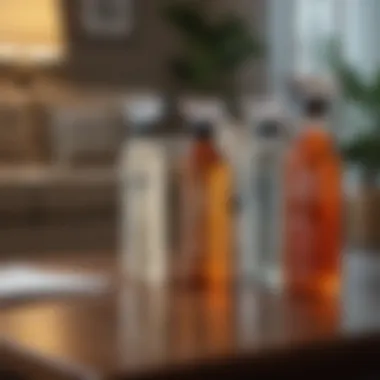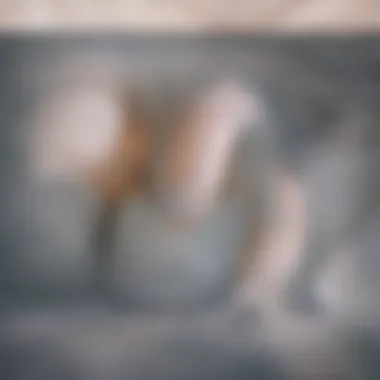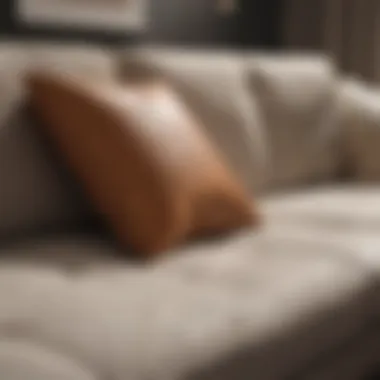Effective Cleaners for Couch Cushions: A Comprehensive Guide


Intro
When it comes to home maintenance, one area often overlooked is the care of couch cushions. These items not only contribute to the overall aesthetic of a living space but also play a crucial role in comfort and usability. Understanding the specific needs of couch cushion cleaning is essential for maintaining their appearance and extending their lifespan.
In this guide, we will delve into various aspects of cleaning couch cushions. We will discuss the types of materials commonly used, the types of stains you may encounter, and the most effective cleaning methods. Additionally, we will share maintenance tips to help you preserve the integrity of your upholstery. This comprehensive resource is tailored to the needs of homeowners and design enthusiasts alike, aiming to refine your approach towards maintaining a neat and inviting seating area.
By exploring the nuances of couch cushion care, you will gain insights that can enhance both the aesthetic appeal of your home and the durability of your furniture.
Understanding Couch Cushion Materials
Understanding the materials used in couch cushions is crucial for selecting the right cleaners and maintenance practices. Different fabrics exhibit various properties that influence their susceptibility to stains and the effectiveness of cleaning agents. By knowing the specific characteristics of each upholstery type, homeowners can make informed decisions that ensure longevity and aesthetic appeal of their furniture. This section will detail common upholstery fabrics, their durability, and care requirements, setting the groundwork for effective cleaning strategies.
Common Upholstery Fabrics
Microfiber
Microfiber is a popular upholstery fabric made from extremely fine synthetic fibers. The key characteristic of microfiber is its soft texture and moisture-wicking properties. This material is often resistant to stains and does not absorb liquids easily, making it a beneficial choice for families or households with pets. Its unique feature is the ability to repel dirt and dust, which simplifies regular maintenance. However, it can be susceptible to fading with harsh sunlight, requiring consideration of placement within the home.
Leather
Leather is a timeless fabric known for its durability and luxurious appearance. The prominent feature of leather is its inherent ability to resist spills. This characteristic makes it a favorable option for those seeking an easy-to-clean material. However, cleaning leather requires specific products to avoid damage. While leather cushions can last for many years, they may need conditioning to prevent cracking over time, presenting both an advantage and a disadvantage in upkeep.
Cotton
Cotton offers breathability and comfort, making it a common choice for couch cushions. Its key characteristic is its natural fibers that provide a soft touch. Cotton is generally easy to clean, but it has a lower resistance to stains, requiring immediate attention to spills. The unique feature of cotton is its ability to be dyed in various colors and patterns, allowing for diverse styles in home decor. Its disadvantage lies in its tendency to shrink or fade if not cared for properly.
Polyester
Polyester is widely used due to its resilience and cost-effectiveness. The key aspect of polyester is its resistance to wrinkles and its strong fiber structure, which makes it an excellent choice for busy households. Unlike natural fibers, polyester does not absorb moisture as easily, which helps in maintaining cleanliness. The unique feature of this material is its ability to hold color well, resulting in long-lasting vibrancy. However, it might not have the same comfort level as natural fabrics, leading to preferences varying among users.
Durability and Care Requirements
Fabric resistance to staining
Fabric resistance to staining plays an essential role in the longevity of couch cushions. The ability of a fabric to repel stains or absorb them varies greatly. Fabrics such as microfiber and leather typically provide high resistance, allowing for easier clean-up after spills. This characteristic reduces the need for frequent cleaning, which can weaken fabric fibers over time. However, less resistant fabrics, like cotton, require consistent care and quick action to maintain their appearance.
Cleansing effects on different materials
Understanding how different cleaning agents interact with varying fabrics helps prevent damage. Microfiber often requires water-based cleaners that do not leave residue, while leather benefits from specific pH-balanced products designed to nourish and protect the surface. Each material has unique needs, making it critical to follow appropriate cleansing methods. Failing to consider these differences can lead to discoloration or degradation of the fabric.
Long-term maintenance considerations
Long-term maintenance is a crucial aspect when discussing couch cushions. Regular upkeep not only enhances the appearance but also prolongs the lifespan of the furniture. Proper cleaning and conditioning of materials like leather can keep them looking new while avoiding cracks. For cotton and polyester, routine vacuuming and spot cleaning can prevent dirt buildup. Adopting a proactive maintenance strategy is beneficial, ensuring the couch remains a central fixture in the living space.
Best Practices for Choosing a Cleaner
Choosing the right cleaner for couch cushions is essential for maintaining their appearance and integrity. Many factors influence this decision, such as the type of fabric and the nature of the stains. By understanding these elements, homeowners can prolong the life of their upholstery and keep their living spaces both clean and appealing.


Factors to Consider
Type of fabric
Understanding the type of fabric is crucial in selecting an appropriate cleaner. Different fabrics have distinct characteristics that can affect the cleaning process. For example, microfiber is often resilient and stain-resistant, making it a preferred choice. However, it can attract dust and dirt easily, requiring regular cleaning. On the other hand, leather offers durability but needs specialized treatments to maintain its luster. Fabrics like cotton and polyester have their own cleaning challenges, such as susceptibility to shrinking or fading. Choosing the right cleaning product based on the fabric type helps ensure effective stain removal without damaging the material.
Stain characteristics
Stain characteristics play a significant role in determining which cleaning solution to use. Knowing whether a stain is water-based or oil-based is important, as each type requires different cleaning methods. For instance, food stains from sauces often need a different approach than greasy stains. A cleaner that can effectively target specific characteristics of stains will yield better results. This knowledge contributes to a more tailored cleaning strategy and prevents the deepening of stains.
Environmental considerations
Environmental considerations become increasingly important in today's world. Selecting eco-friendly cleaners can greatly reduce harm to both the environment and household members. Many traditional cleaners contain harsh chemicals, which can produce harmful fumes and cause skin irritations. Opting for biodegradable options not only supports a healthier home but also aligns with sustainable practices. Moreover, products with natural ingredients often provide safe yet effective alternatives, striking a balance between efficacy and environmental stewardship.
Common Ingredients in Cleaners
Enzymatic cleaners
Enzymatic cleaners are exceptionally effective for breaking down organic stains. They contain specific enzymes that target proteins and fatty substances, making them ideal for food or pet stains. Their ability to digest stains at a molecular level sets them apart from conventional cleaners. While they tend to be more suitable for particular types of stains, users may find that they require a longer application time to achieve optimal results.
Non-toxic alternatives
Choosing non-toxic alternatives contributes positively to home safety and health. These products avoid harsh chemicals, making them safe for families, including children and pets. Non-toxic cleaners often rely on plant-based ingredients, which can still be effective against stains without posing risks. The primary disadvantage may be the need for more effort and time to achieve desired results, especially on tough stains; however, the trade-off in safety is often worth it.
Commercial versus homemade options
When weighing commercial versus homemade options, it's important to consider cost, effectiveness, and ease of use. Commercial cleaners often provide a quick solution with established effectiveness. However, they may contain harmful chemicals. In contrast, homemade options can utilize common household ingredients like vinegar or baking soda. While homemade solutions may take longer to prepare, they offer a customizable, often non-toxic approach. The choice between these two paths ultimately depends on personal preferences and specific cleaning needs.
Types of Stains and Appropriate Cleaning Solutions
Understanding different stains that can affect couch cushions is crucial for effective cleaning. Knowing the nature of each stain helps in selecting the most appropriate cleaning solution. Some stains are more challenging to remove than others, and certain fabrics may react differently to cleaners. Thus, identifying the stain type allows for tailored approaches that can maintain the upholstery's condition while enhancing its longevity.
Food and Beverage Stains
Food and beverage stains are common household challenges. They differ in composition, making specific cleaning approaches necessary for effective removal.
Coffee and tea
Coffee and tea can leave behind stubborn stains due to their deep colors and tannins. Both beverages are widely consumed, and spills are likely to happen. The acidic nature of coffee can penetrate fabric fibers, making it significant to act quickly. Using a cleaner specifically formulated for dark stains can help lift these marks effectively. However, care should be taken with delicate fabrics, as some cleaners may affect the color of the upholstery.
Grease and oil
Grease and oil stains are often a result of cooking or eating on the couch. These stains are particularly tricky because they can be absorbed into the fabric, leading to persistent marks. The key characteristic is their oily texture, which requires absorbent materials or cleaners designed to break down oily substances. A cleaner with a degreasing agent is often beneficial. However, if not treated properly, grease stains can become permanent, making early intervention crucial.
Fruit and sauce stains
Fruit and sauce stains often combine both color and acidity. These stains not only alter the fabric’s appearance but can also attract pests if left untreated. The unique feature of these stains is their diverse composition, which means a one-size-fits-all approach may not work. Typically, an enzymatic cleaner can effectively break down sugars and organic compounds found in many sauces and fruits. Still, caution is required to avoid damaging the fabric.
Pet and Miscellaneous Odors


Pet-related stains and odors can disrupt the comfort of a home. Understanding solutions for these issues can greatly improve living conditions and maintain the appeal of couch cushions.
Pet urine cleaning solutions
Pet urine can cause significant damage to upholstery if not handled promptly. The key characteristic of pet urine stains is their strong odor and potential to cause discoloration. Products with enzymatic properties can break down urine compounds, neutralizing odors and preventing re-soiling. The downside is that some cleaning products can have strong fragrances, which may or may not be suitable for sensitive individuals.
Removing musty odors
Removing musty odors is essential for a fresh living environment. These odors may result from moisture and lack of air circulation. A beneficial approach is using a solution that neutralizes odors, such as those containing baking soda or vinegar. These substances are inexpensive and widely available. However, they may require repeated application, especially if the source of the mustiness is not eliminated.
General disinfecting methods
General disinfecting methods serve to eliminate germs and odors that can accumulate over time. These methods typically involve the use of disinfecting wipes or sprays that are safe for upholstery. They can be useful in preventing the spread of bacteria and maintaining a clean surface. Yet, it's important to verify that the products used do not harm the fabric. Regular disinfection contributes to a better living space overall.
Step-by-Step Guide to Cleaning Couch Cushions
Cleaning couch cushions involves a methodical approach. Understanding the steps can enhance the results and ensure that one does not damage the fabric. This section provides a structured way to clean cushions effectively while maintaining their quality, which ultimately contributes to a cleaner and more inviting living space.
Preparation and Gathering Materials
Essential tools and products
For effective cleaning, it is crucial to have the right tools and products. A vacuum cleaner, upholstery brush, and specific fabric cleaners are essential. Vacuuming removes dirt and debris before any liquid cleaners are applied, reducing the chances of stains setting in. Upholstery brushes are helpful in agitating dirt from fabrics without causing damage.
Moreover, purchasing a cleaner suitable for your couch's fabric type is beneficial. For example, using enzymatic cleaners for organic stains like food or pet messes can enhance stain removal without damaging the material. Additionally, being informed about the fabric helps in selecting cleaners that won’t cause discoloration or fading.
Testing cleaner on inconspicuous area
Before applying any cleaner, testing on a hidden section of the fabric is a wise decision. This step helps in confirming that the cleaner does not adversely affect the color or texture of the fabric. It is a simple, yet effective way to prevent potential damage.
Most fabric cleaners have usage instructions, but individual fabric types react differently. Therefore, spot-testing can ensure compatibility with the specific material of the cushion, leading to optimal cleaning results.
Safety precautions
When cleaning couches, safety should be a priority. It is essential to read the instructions and safety warnings on cleaning products. Some cleaners may contain chemicals that could cause irritation or other health issues.
Using gloves while handling cleaning products can protect your hands. Ensuring the room is well-ventilated can help minimize exposure to fumes. Not every cleaner is suitable for indoor use, so opting for non-toxic alternatives can provide a safer environment for both the cleaning process and the occupants.
Cleaning Techniques for Different Fabrics
Spot cleaning techniques
Spot cleaning is essential for addressing specific stains without needing to clean the entire cushion. This targeted approach uses a small amount of cleaner directly on the stain. By dabbing the stain gently with a clean cloth, one can often lift the stain without spreading it.
This method is particularly effective for food and drink stains, as treating them quickly can prevent permanent damage. However, it requires care to ensure the cloth used is white or color-fast to avoid leaving any dye on the fabric.
Full upholstery cleaning methods
Full upholstery cleaning methods are typically needed for a deep clean. This process involves cleaning the entire cushion cover or the couch itself, allowing for a more thorough removal of dirt, dust, and allergens. Most full cleaning methods involve the use of a vacuum followed by steam cleaning or gentle washing, depending on the fabric.


Steam cleaning can be particularly beneficial as it uses heat to break down dirt and sanitize fabric without harsh chemicals. However, it is crucial to know the heat tolerance of the fabric to avoid damage.
Drying and airing procedures
After cleaning, proper drying techniques are vital for maintaining the integrity of the cushions. Airing the cushions in a well-ventilated area helps prevent mildew and odors from developing.
In addition, ensuring that the cushions dry completely before putting them back onto the couch is important. Many cushions can be damaged by moisture if stored improperly after cleaning, leading to unpleasant smells or mold growth.
Ensuring a comprehensive cleaning and drying process can greatly extend the life of couch cushions. Regular attention to cleaning details promotes a healthier indoor environment.
Maintenance and Prevention Strategies
Effective maintenance and prevention strategies are crucial for ensuring the longevity of couch cushions. Regular care not only maintains the visual appeal but also saves money in the long run by extending the life of upholstery. Households can invest time in upkeep while minimizing the need for costly repairs or replacements. Implementing systematic cleaning practices can significantly reduce dirt buildup and staining, which are common issues that arise over time. Developing a routine tailored to specific fabrics can help homeowners avoid damage and keep cushions looking fresh.
Regular Cleaning Schedule
Weekly and monthly routines
Establishing a weekly and monthly cleaning routine is essential for upholstery maintenance. These routines help reduce the accumulation of dust, allergens, and stains on cushions. Weekly cleanings can consist of light vacuuming to remove dirt and crumbs. Monthly assessments can include deeper cleaning methods, such as spot treatments for stubborn marks. The key characteristic of a regular schedule is that it promotes consistency, helping to maintain a clean environment without overwhelming effort. This approach is advantageous as it prevents minor issues from escalating into major problems, preserving the couch’s overall integrity.
Annual deep cleaning considerations
Annual deep cleaning should not be overlooked, as it serves as a thorough assessment of the upholstery's condition. A deep clean typically involves professional services or the use of powerful upholstery cleaners to address any deep-seated stains or odors. The critical aspect of this practice is that it allows homeowners to restore the original look and feel of their cushions effectively. While this choice can be more labor-intensive and costly than regular cleanings, the benefit lies in its long-term impact. It ensures a comprehensive refresh of the cushions, potentially extending their usability significantly.
Impact on prolonging cushion life
Regular maintenance and the incorporation of deep cleaning sessions will have a direct impact on prolonging the life of couch cushions. This proactive approach reduces wear and tear, preserving the structure and aesthetic of the upholstery. The unique feature of a well-planned maintenance strategy is not only the visible cleanliness but also the comfort it retains. Invested effort translates to sustainability, allowing cushions to withstand daily use. Thus, durability and appearance are achieved through a lifetime commitment to care and preservation.
Protective Measures
Couch covers and protectors
Using couch covers and protectors is a proactive strategy in preventing damage. These protective layers guard against spills, dirt, and wear, all of which can be detrimental over time. The key characteristic of these products is their versatility; they come in different materials and sizes to fit various couch styles. Investing in a quality cover can be seen as a beneficial choice for those wanting to maintain the look of their cushions for longer. However, one must also consider potential disadvantages, such as fit issues or the aesthetics of the cover.
Furnishing arrangement to mitigate wear
The arrangement of furniture and cushions plays an important role in minimizing wear. Proper placement can prevent direct sunlight exposure, which can fade colors and weaken fibers. A common practice involves repositioning seats and cushions from time to time to promote even wear. The characteristic of this method is its subtle nature; it requires minimal effort with profound benefits. Nonetheless, it might require homeowners to be more mindful of their arrangement habits, making it somewhat challenging in high-traffic areas.
Choosing stain-resistant fabrics
Choosing stain-resistant fabrics is a practical measure for effective cushion maintenance. These materials are designed to repel spills, making them easier to clean and maintain. The key advantage of selecting such fabrics is their resilience, leading to fewer deep cleanings over time compared to standard options. This makes it a popular choice among homeowners seeking both aesthetic appeal and low-maintenance solutions. One challenge, however, is the potential limitation in fabric styles available, as more trendy options may not fit into the stain-resistant category.
Culmination
In the context of maintaining your couch cushions, the conclusion serves as a critical reaffirmation of key insights discussed throughout this article. It emphasizes a cohesive understanding of best practices in selecting and using effective cleaners tailored for various materials. The focus on specific elements lies in reinforcing the importance of recognizing the unique attributes of each upholstery fabric, the inherent stain characteristics that different environments present, and the subsequent impacts these factors have on cleaning techniques.
Recap of Best Practices
To encapsulate the guidance offered, best practices for cleaning couch cushions encompass several essential actions:
- Know Your Fabric: Understanding the material ensures that the cleaning solution used is safe and effective. Always consult care labels.
- Choose the Right Cleaner: Opt for cleaners that suit the fabric type. Consider enzymatic options for organic stains, while mild detergents work best for everyday cleaning.
- Test before Application: Testing cleaners on an inconspicuous area can help prevent damage.
- Adopt Regular Maintenance: Consistent cleaning routines, as outlined earlier, are vital for preserving the integrity of furniture.
Long-term Benefits of Clean Couch Cushions
The importance of maintaining clean couch cushions transcends mere aesthetics. Here are several notable long-term benefits:
- Enhances Longevity: Regular cleaning prevents the buildup of dirt and stains, extending the life of your upholstery.
- Improves Air Quality: Clean cushions contribute to a healthier indoor environment by minimizing allergens and odors.
- Retains Aesthetic Appeal: A well-maintained couch remains visually appealing, which is fundamental in home decor and ambiance.
- Increases Comfort: Clean cushions offer a more pleasant seating experience, emphasizing the effect of cleanliness on functionality.
Accessible information and practical methods lead to informed decisions about upholstery care. Embracing these practices not only elevates the overall environment but also ensures that investments in furniture remain worthwhile.







